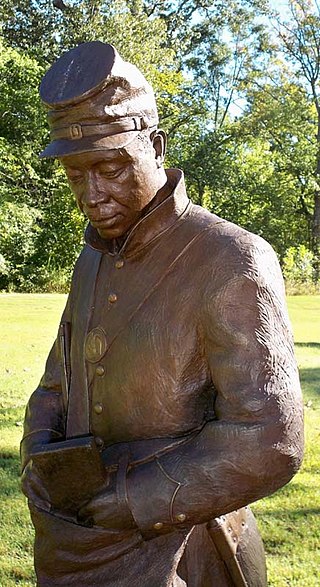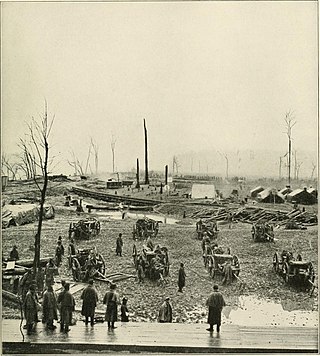
United States Colored Troops (USCT) were Union Army regiments during the American Civil War that primarily comprised African Americans, with soldiers from other ethnic groups also serving in USCT units. Established in response to a demand for more units from Union Army commanders, by the end of the war in 1865 USCT regiments, which numbered 175 in total, constituted about one-tenth of the manpower of the army. Approximately 20% of USCT soldiers were killed in action or died of disease and other causes, a rate about 35% higher than that of white Union troops. Numerous USCT soldiers fought with distinction, with 16 receiving the Medal of Honor. The USCT regiments were precursors to the Buffalo Soldier units which fought in the American Indian Wars.

The Battle of Fort Pillow, also known as the Fort Pillow massacre, was fought on April 12, 1864, at Fort Pillow on the Mississippi River in Henning, Tennessee, during the American Civil War. The battle ended with Confederate soldiers commanded by Major General Nathan Bedford Forrest massacring U.S. Army soldiers attempting to surrender. Military historian David J. Eicher concluded: "Fort Pillow marked one of the bleakest, saddest events of American military history."
The 1st Regiment Alabama Siege Artillery (African Descent) was an artillery regiment recruited from African-Americans that served in the Union Army during the American Civil War. The regiment was renamed the 6th US Colored Heavy Artillery. Under the leadership of Major Lionel Booth, the regiment fought at the Battle of Fort Pillow on April 12, 1864. The regiment then became the 7th US Colored Heavy Artillery, and later the 11th United States Colored Infantry.
The 9th Louisiana Infantry (African Descent), later reorganized as 1st Mississippi Colored Heavy Artillery and then renamed 5th U.S. Colored Heavy Artillery, was an African-American regiment in the Union Army during the American Civil War. It famously fought in the Battle of Milliken's Bend; one of the earliest Civil War battles with African-American troops involved.

Camp Nelson National Monument, formerly the Camp Nelson Civil War Heritage Park, is a 525-acre (2.12 km2) national monument, historical museum and park located in southern Jessamine County, Kentucky, United States, 20 miles (32 km) south of Lexington, Kentucky. The American Civil War era camp was established in 1863 as a depot for the Union Army during the Civil War. It became a recruiting ground for new soldiers from Eastern Tennessee and enslaved people, many of whom had fled their living conditions to be soldiers.

The Memphis massacre of 1866 was a series of violent events that occurred from May 1 to 3, 1866 in Memphis, Tennessee. The racial violence was ignited by political and social racism following the American Civil War, in the early stages of Reconstruction. After a shooting altercation between white policemen and black veterans recently mustered out of the Union Army, mobs of white residents and policemen rampaged through black neighborhoods and the houses of freedmen, attacking and killing black soldiers and civilians and committing many acts of robbery and arson.
The 1st Tennessee Heavy Artillery Regiment (African Descent) was an artillery regiment that served in the Union Army during the American Civil War.
The Memphis Battery Light Artillery (African Descent) was an artillery battery that served in the Union Army during the American Civil War. The unit was also called 1st Tennessee Battery (African Descent).
The 48th Ohio Infantry Regiment was an infantry regiment in the Union Army during the American Civil War.
The 11th United States Colored Heavy Artillery Regiment, previously designated the 14th Rhode Island Heavy Artillery Regiment (Colored), was an African American artillery regiment that served in the Union Army during the American Civil War.

The 4th Missouri Colored Infantry Regiment was an African-American infantry regiment that served in the Union Army during the American Civil War. Redesignated as the 68th U.S. Colored Troops Regiment on March 11, 1864.

The 55th United States Colored Infantry Regiment was a United States Colored Troops infantry regiment in the Union Army during the American Civil War. It was first organized as the 1st Alabama Volunteer Infantry Regiment (African Descent) in May 1863, serving on garrison duty at Corinth, Mississippi and Memphis, Tennessee. It was redesignated as the 55th United States Colored Infantry in March 1864, continuing its garrison service in Tennessee and fighting at the Battle of Brices Cross Roads. After the end of the war, the regiment was mustered out in late 1865 after garrison duty in Louisiana.
The 18th United States Colored Infantry Regiment was an African-American infantry regiment, raised in the state of Missouri, which served in the Union Army during the American Civil War.

The 46th United States Colored Infantry was an infantry regiment that served in the Union Army during the American Civil War. The unit was originally designated as the 1st Arkansas Infantry Regiment. The regiment was composed of African American enlisted men commanded by white officers and was authorized by the Bureau of Colored Troops which was created by the United States War Department on May 22, 1863.
The 44th United States Colored Infantry was an infantry regiment that served in the Union Army during the American Civil War. The regiment was composed of African American enlisted men commanded by white officers and was authorized by the Bureau of Colored Troops which was created by the United States War Department on May 22, 1863.
The 59th United States Colored Infantry was an infantry regiment that served in the Union Army during the American Civil War. The regiment was composed of African American enlisted men commanded by white officers and was authorized by the Bureau of Colored Troops which was created by the United States War Department on May 22, 1863.

The 3rd United States Colored Cavalry was a regiment in the United States Army organized as one of the units of the United States Colored Troops during the American Civil War. The regiment was originally formed in October 1863 at Vicksburg, Mississippi as the 1st Mississippi Cavalry Regiment. The unit soon began taking part in expeditions near Vicksburg. In February–March 1864, the regiment saw action at Yazoo City. After being renamed the 3rd U.S. Colored Cavalry in March 1864, the regiment continued to participate in raids, including the Yazoo City expedition in May. In December 1864, the unit took part in a successful raid led by Benjamin Grierson during which the Battle of Egypt Station and other actions were fought. The regiment operated near Memphis, Tennessee, until April 1865, after which it returned to Vicksburg for occupation duties. The soldiers were mustered out of federal service in January 1866.

The 1st Regiment, United States Colored Heavy Artillery (USCHA) was a unit of the United States Army during the American Civil War.









